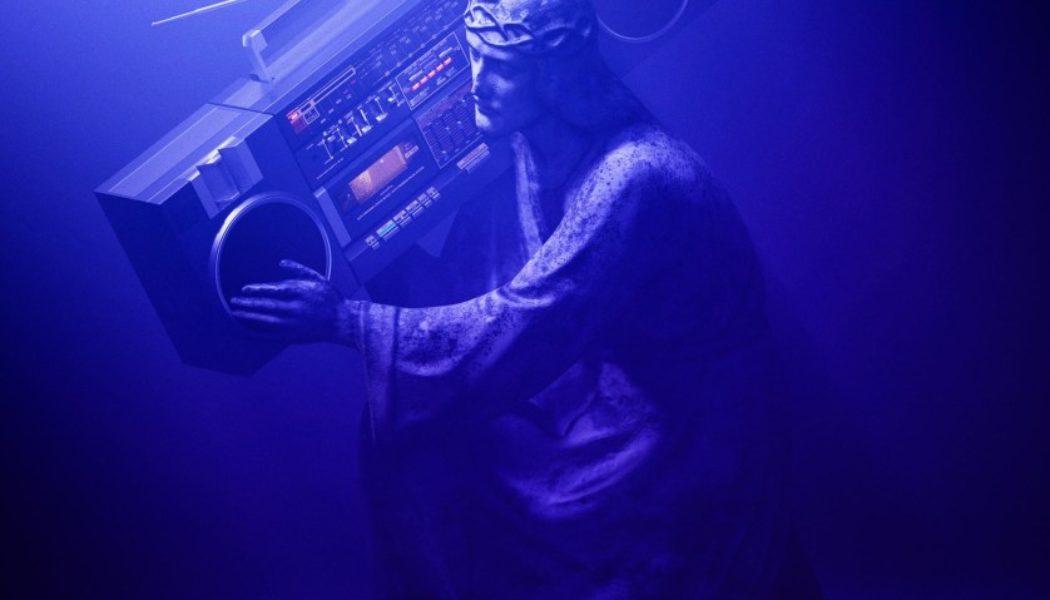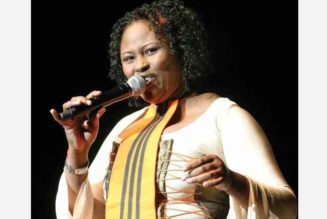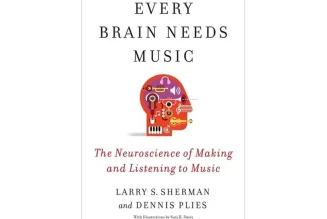L
ooking out the studio window of the radio station where she’d worked for 29 years, DJ “Mistress Carrie” Sarao could see a crowd gathering outside. It was a Friday night, Feb. 21, 2020, and freezing, but that didn’t stop hundreds of Bostonians from flooding the parking lot when they heard the news. There was no invitation, just an impulse, an impromptu meetup of loved ones known and unknown. At midnight, the city would lose its last rock radio station.
Debuting in 1970, WAAF helped launched the careers of local bands like Aerosmith and Godsmack, and put national groups like Shinedown on the map. To many listeners, the station was as much a part of Boston as Fenway Park and clam chowder. WAAF was, Mistress Carrie’s longtime colleague and fellow WAAF DJ Mike Hsu told me, a “local Massachusetts club of troublemakers and assholes.” At big rock concerts, chants of “ ’AAF! ’AAF!” were as common as feedback. Sometimes WAAF loyalists would come to blows with devotees of their onetime competitor — rock station WBCN — before the latter went off the air in 2009. For Mistress Carrie, a 51-year-old, purple-haired rock evangelist, WAAF was the soundtrack to her adolescence, as it had been for so many other Bostonians.
In the days leading up to the end, the mood at WAAF was somewhere between hospice care and a rowdy Irish Catholic wake. Old friends flooded in; listeners called with high-octane send-offs; Aerosmith’s Tom Hamilton stopped by to pay tribute. But as the clock ticked toward midnight, there was a quiet in the on-air studio. Mistress Carrie’s voice broke as she told her listeners to keep their heads high, shoulders back, and horns up. “We’re goin’ out proud,” she said. “Because we were all part of something special.”
“It was awesome,” Hsu replied solemnly.
Six minutes before midnight, Mistress Carrie and Hsu taunted the soon-to-be owners of their beloved station.
“There’s only one way to go,” Mistress Carrie said.
“Loud,” Hsu stated.
“In your face,” replied Mistress Carrie.
“Evil,” Hsu declared authoritatively.
Crackling in the background was the soft but ominous sound of rain falling and church bells ringing — the iconic opening of Black Sabbath’s 1970 track “Black Sabbath.” The song was “handcrafted, especially chosen” for “the segue into the new format,” according to Hsu — intended, Mistress Carrie told me, to “inject as much satanism in the airwaves as possible before we flipped the switch.”
“Wherever you are,” Mistress Carrie implored her listeners, her voice breaking, “roll your windows down!”
“Crank it up!” yelled Hsu.
“One last time, baby!” Mistress Carrie spat out, before screaming a chant that had rung through Boston’s rock scene for half a century.
“’AAF! ’AAF!” she yelled, with Hsu joining in. About 150 current and former employees, crammed into the adjacent office space, opened the door to join in. Their chanting voices filled the airwaves. “’AAF! ’AAF!” With their final song growing louder, the DJs faded out the mics and closed the studio door. “And [we] sat there with our headphones on,” Mistress Carrie says, “and cried.”
Perfectly timed by Hsu and Mistress Carrie, the song ended at midnight, when an engineer came in and flipped a switch, ending WAAF’s transmission once and for all. In the studio, all was silent save for the tears of Mistress Carrie and Hsu.
Listeners, though, heard something else: the impersonal dawning of a new era. There was no flashy sign-on, no new local DJ to take the reins as the frequency changed hands. The new owners couldn’t be bothered to tip their hat to their new Boston audience with a shout-out or a song by a local artist. Instead, they just punched into their automated playlist, which emanates via satellite to hundreds of radio stations across the country, fading in midsong. With the signature clean production and contemplative, easy pace of Christian rock, artist Jeremy Camp’s 2006 track “Let It Fade” invited listeners to be saved, to find new life. WAAF had just become the latest casualty in a string of radio stations all over the country, all lost to a massive but little-known nonprofit called the Educational Media Foundation.
If you’ve ever wondered why it seems like every other station on your dial is Christian rock, EMF is a big part of your answer. From its headquarters in a Nashville suburb (the organization is slowly relocating from its longtime home of California), EMF plays the generic sounds of contemporary Christian music, or “CCM.” It is a genre that everyone from artists and critics to church leaders have decried as being somewhere between “the absolute worst” and “doctrinally unsound.” But the Educational Media Foundation has quietly become the country’s fastest-growing radio chain and second-largest station owner in the country, bested only by iHeartRadio. With hundreds of cookie-cutter stations branded as “K-LOVE,” as well as its smaller chain of “Air1” stations, EMF broadcasts on more than 1,000 signals across all 50 states and some U.S. territories, reaching an estimated 18 million listeners a week.
While EMF stations may not have the “rage-inducing content” of an outlet like Fox News, says historian Leah Payne, they are “the softer side of that conservatism.”
On the surface, EMF’s broadcasts are glaringly apolitical. They opt instead for their trite brand of Christian rock, all teed off by the same, small cast of nationally syndicated, Anywhere-USA DJs who smile through everything from squeaky-clean jokes about the drink sizes at Starbucks to prayers asking God to watch over those who have donated to the organization. But behind its politically neutral facade, the organization — and the CCM industry more broadly — appears to be an inherently conservative project. Many right-wing Christian culture bearers have long believed in the “Breitbart Doctrine” — the idea that, to change politics, you must first change culture — and have fought for decades to build a parallel popular culture free of sharp edges, hard questions, or representations of lives that veer from the straight and narrow. The world of CCM, in turn, “reflects the values of the religious right,” says religious-studies historian Leah Payne, by providing “suburban families with safe Christian listening experiences in the car.” And while EMF stations may not have the “attention-getting, rage-inducing content” of an explicitly political outlet like Fox News, she says, “K-LOVE is the softer side of that conservatism.”
Today, the organization’s nationwide network of radio stations plays mostly white, male artists. Though it professes to broadcast “Christian music,” it largely steers clear of genres like religious rap or gospel, as well as any Christian rock that grapples too heavily with doubt or hardship. Christian artists who have wavered in their faith have quietly been dropped from EMF’s playlists; several queer Christian artists have lost work and airtime on CCM radio after coming out. (Through a representative, EMF declined to be interviewed for this story and did not respond to requests for comment.)
But EMF’s story isn’t just about bad music taking over the airwaves in service of a cultural vision that is overwhelmingly white, straight, and artistically regressive. It’s also the story of the near-demise of local radio — a longtime haven for new music, artistic outcasts, and political dialogue — at the hands of a tax-avoiding not-for-profit organization that appears to operate like a very-much-for-profit media mega-corporation. For decades, EMF has hidden behind a veneer of uncoolness while honing a signature technique: At big commercial stations and small, beloved community-radio stations alike, they’ve offered the owners an undeniable sum of money, wiped out the local presence, and replaced it with unmanned transmitters. Almost every new EMF station operates as a repeater with no local voices, few local jobs, and barely any overhead.
As of 2022, the little-known organization had just shy of a billion dollars in net assets (a number that grows steadily year after year), with an annual revenue of nearly a quarter billion. (National Public Radio, by comparison, had net assets of less than $150 million, and operated near the break-even mark.) In 2021, EMF’s then-CEO Bill Reeves made a cool $770,000 a year — well over what NPR’s CEO made that year. (Compensation data for EMF’s current CEO, Todd Woods, has yet to be released.) And listeners are the primary ones paying that salary: Ninety-seven cents of every dollar the organization makes comes directly from listeners’ pockets. EMF’s on-air hosts repeatedly hound their sometimes hard-up listeners for money, often several times in an hour. With few operating costs, each new station quickly becomes a vehicle for new donations. While other radio companies sell off signals and struggle to keep advertisers, nonprofit EMF has built an unassuming money-making machine.
In the WAAF studio that last fateful night, some staff were feeling whiplash. Just three years earlier, Hsu watched as the station he grew up with, Brown University’s WBRU in Providence, Rhode Island, was choked off the air in an EMF buyout. WAAF program director Joe Calgaro, sitting next to Hsu, had his longtime dream of working at his hometown rock station — the Loop, in Chicago — pulled out from under him when EMF bought it in 2018 for $21.5 million. In the case of Boston’s WAAF, the organization paid more than $10 million for the signal.
Instead of new rock bands and a few classic standbys, listeners in the Boston area can now hear a small and frustratingly catchy playlist of guitar-driven worship songs, interspersed with promotions for EMF apps that allow you to listen everywhere — “even the Chili’s parking lot!”
“They might not ever say it out loud,” says Mistress Carrie, “but you can’t tell me there isn’t a little bit of pride that K-LOVE is taking the devil’s music off the radio and buying rock stations out.”
According to an interview with recent CEO Reeves on a Christian-radio website, EMF’s “signal expansion” team sits down together every 10 days to continue plotting its growth. The group of engineers, executives, and money guys look at stations that might be vulnerable to a buyout, and hatch plans. And EMF built its kingdom by expertly exploiting loopholes that the Federal Communications Commission (FCC) put in place to help small nonprofits and try to keep the broadcast spectrum from falling to those with the deepest pockets. In 2018, former EMF CEO Mike Novak told a radio-industry magazine that “in my own heart, I know God was involved” in the decision to form a 501(c)(3), “because being a not-for-profit has paid off for us many, many times.”
To Mistress Carrie, it didn’t feel fair. When it comes to music radio, she says, “they’re playing on a completely separate set of rules than everybody else.”
In 1978, BOB Anthony Fogal was working his dream job as a DJ at KFRC, a San Francisco rock and Top 40 station that had been named Billboard’s Station of the Year four times in a row. But Fogal, 28 years old with a bright smile, iconically Seventies big-frame glasses, and a slightly shaggy beard, was also a recent convert to evangelical Christianity — and he was feeling unexpectedly unfulfilled. Sitting in his office, he scrawled an idea on a yellow pad of paper: “Christian KFRC?!” At the time, a lot of Christian radio was still fringe: sharp-tongued preachers from small-town churches prophesying about the end times. And while Fogal may have personally embraced this kind of religiosity, he had something else in mind for his radio station. He wanted to reach the masses. “No Christian-ese,” he wrote on the paper with a bold underline.
Two years later, Fogal went public with his effort, forming the nonprofit that would soon be known as the Educational Media Foundation. They ran ads in the local paper with open invitations for anyone wishing to discuss the creation of a new Christian-music radio station. They held early-morning prayer gatherings and film screenings, raising money by charging $5 a head. It wasn’t easy, but it was his calling: Fogal, who had been living a plush life in Marin County, would come to sell many of his belongings to make his vision come to life.
By 1982, Fogal and his followers had scraped together enough to buy an FM station that had belonged to a bankrupt church in Santa Rosa, California. On the Educational Media Foundation’s flagship station, Fogal bucked Christian-radio convention by almost exclusively playing music — all optimistic and Jesus-tinged. Though leaders of local churches scoffed, some audience members were so moved that they wanted to do more than listen. Volunteers put on concerts, created a newsletter, held an annual auction, helped solicit donations, and rallied listeners to pray for more frequencies.
Their prayers were answered by Army-disciplined pop-radio DJ Dick Jenkins, who came in as general manager in 1986. Jenkins rebranded the flagship station and began using the slogan “Positive and Encouraging: K-LOVE” — which the organization still uses today. It started negotiating buyouts — often with small, struggling Christian radio stations. New stations rebroadcasting K-LOVE sprung up around Northern California, and eventually in some small towns and midsize cities throughout the country. With Jenkins at the helm, EMF’s chain of near-identical stations grew steadily throughout the 1980s and 1990s.
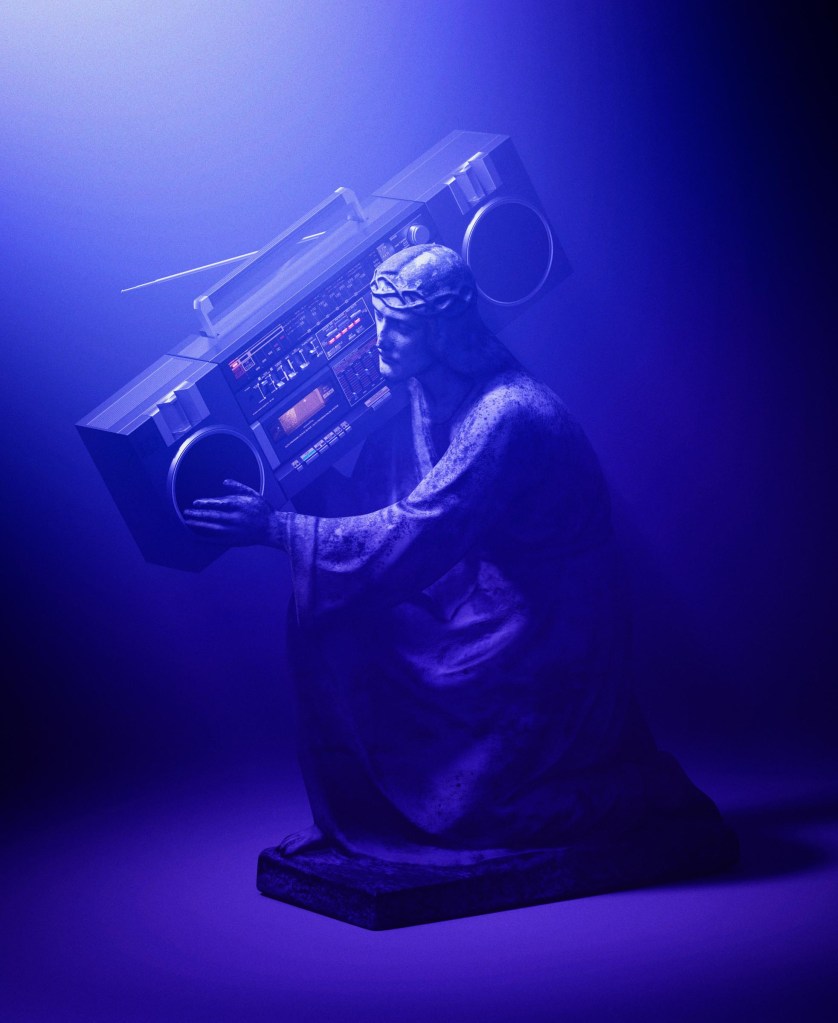
Illustration by Guillem Casasús
As the company built its broadcast network, one business decision proved to be peculiarly prescient: the choice to incorporate as a “not-for-profit” entity. Not only did that status let it avoid paying tax, it also gave EMF several legs up in the radio world. It allowed the organization to take advantage of long-held FCC policies intended to keep the radio dial from being sold to the highest bidder, such as waiving application costs and other fees for nonprofits due to their inherently “limited funding.” EMF also made use of a federal policy that let new nonprofit stations opt out of the requirement of having a local broadcast studio. Furthermore, EMF could legally get donations from listeners — a revenue stream commercial stations don’t have at their disposal. For EMF, “it was just a matter of expansion,” says Todd Urick, a radio engineer and community-radio advocate in Los Angeles County. By the early 2000s, the nonprofit had well over 50 radio stations and was bringing in around $25 million in donations annually.
In 2003, EMF leveled up again. That spring, the FCC set aside a week in which radio organizations could apply for radio “translators” — in essence, small repeater stations that rebroadcast a parent station into an area that the original signal couldn’t reach. Translators are a fraction of the price of new stations, and were easily available to nonprofit broadcasters like colleges, public radio stations, and community and religious broadcasters. After that March week in 2003, Urick was sifting through the FCC’s digital database to see who had applied. “EMF,” he says, “was a major filer of these translators.” In fact, the organization had applied for nearly 900 translator stations across the country, including coveted signals in big cities. They’d get approved for more than 250. With an explosion of new translators broadcasting Christian music, EMF soared: By 2006, the nonprofit more than quadrupled its assets, to more than $80 million; by the end of that year, EMF was the world’s largest broadcaster of contemporary Christian music.
But perhaps most disturbing of all is that, from the beginning, EMF’s nonprofit status has let it access a gold mine of frequencies: the storied “left of the dial.” The FCC has long reserved the lower FM band — from 88.1 to 91.9 — for exclusive use by groups including colleges, community and public-radio organizations, and tribes. It’s the stuff of subcultural legend, and the inspiration for the Replacements’ 1985 ode to college radio, “Left of the Dial.” With big, commercial entities banned from bidding on these signals, the FCC imagined that small nonprofits could access them. But with a giant like EMF still entitled to these frequencies, small organizations have found it hard to compete: In 2015, listeners and staff at a classical public-radio station in South Florida couldn’t raise enough to buy back their frequency after it was sold to EMF. In 2017, not even a media-savvy campaign led by current and former Brown University radio staffers could keep the frequency out of EMF’s hands. And in 2018, EMF bought Shaw University’s signal, which had been the first public-radio station owned by an HBCU; the more than 2,000 signatures on Change.org weren’t even a hiccup. Even as EMF grew into a giant, it still reaped the benefits designed to give small nonprofits a fighting chance on the radio dial.
If you ask Urick, EMF has also been a behind-the-scenes bully. He says he has “run into several cases” where EMF has made small engineering changes that have “practically no effect” on EMF’s reach, but limit a nearby community broadcaster’s coverage — or keep an organization that was hoping to get a new station from getting on the air. Like in 2013, when the nonprofit punk fanzine Razorcake applied for a tiny Los Angeles-area FM station on the same signal as an EMF translator down in Orange County, and EMF barraged it with complaints about potential interference. “It was kind of like the NFL going after a peewee team,” says zine editor Todd Taylor. “They were just trying to bury us in paperwork.” (Full disclosure: I was interviewed by Razorcake last year and worked in community radio many years ago.) Urick also says that, over the years, he has watched EMF buy up multiple translators in the same city — doubling, sometimes tripling up their coverage. “They hoard [signals] where they don’t even need them, where they’re extremely redundant.” And that, Urick says, takes away potential signals from community-radio hopefuls.
In cities and small towns alike, EMF moves in like a ghost — almost imperceptible but ever-present — with virtually no local staff or local facilities, without paying the fees required of commercial radio companies, and on frequencies unavailable to the commercial networks that are, increasingly, its competitors. But when asked in 2022 about EMF’s localism — or lack thereof — by Christian website HisAir.net, then-EMF CEO Reeves put it in holy context: “Well, the answer is pretty simple. That’s just not what we are called to do at this time.”
FROM HER SEAT behind the microphone at WAAF in the 2010s, Mistress Carrie saw EMF’s K-LOVE and Air1 stations spreading to more and more frequencies. But she never saw them as a threat: “I’ve always said it’s my opinion that the devil writes better music than God.” Christian rock, she says, “was more of a punchline” for her and her colleagues.
But in the CCM industry, getting that immediately recognizable sound — however derided — has been a science. “You just can’t be too heavy,” says Grace Semler Baldridge, an independent Christian artist who performs as Semler and who has topped both the iTunes Christian albums and song charts. In addition to her own crop of frankly honest songs about her faith, she’s done session work and built relationships with artists in the CCM industry. There, she immediately became aware of a few soft rules of the genre.
First, she says, there’s a just-right spot when it comes to beats per minute — not too fast, not too slow. After BPMs, there are “JPMs,” or “Jesuses per minute.” While there’s no hard-and-fast rule on the required number of JPMs, more tends to be better — and a reference to “Him,” “God,” “Father,” etc., counts, Semler says. Choruses should be rife with repetition so that listeners can sing along by the second round. The guitar must be warm but just a bit bright, with a touch of drive and a long-tail reverb that hangs in the air. Most important, there’s the delay, which nearly doubles the guitars’ slow strums and picked melodies — a technique that Reverb.com’s “The Gear, Tones, and Techniques of Modern Worship Guitar” guide says was pulled directly from U2’s the Edge.
In many ways, EMF helped shape this sound over decades; one evangelical-church band member I spoke with called it “K-LOVE-ificiation of Christian music.” With hundreds of stations rebroadcasting a single K-LOVE feed, Christian artists and record labels saw that they had a singular opportunity. Instead of shipping CDs to dozens of stations the country over, pleading with program directors for airtime, and racking up long-distance phone bills, artists and their labels had to convince just one set of people that their song was worth playing: those deciding the playlist at EMF.
There’s no set rule on how many “JPMs” — “Jesuses per minute”— a CCM song needs, but more tends to be better. References to “Him,” “God,” and “Father” count.
In the 1980s and 1990s, K-LOVE could be heard playing Christian pop rock and crossover artists like Amy Grant. Its sister chain, Air1, focused more on Christian “alternative” music, anchored over the years by bands like dc Talk and Relient K. But over time, K-LOVE and Air1 converged on a niche in the marketplace: the rock-tinged, undoubting pop of “worship” music — “the sound of the megachurch,” as Leah Payne describes it. The Christian-music business’s target audience member — whom industry leaders brazenly refer to as “Becky” — is a full-time mom who desperately wants a reliably unoffensive station to play in the car while carting the kids from school to soccer. With a suburban sound, the songs are just as easily heard on Sunday morning as in the car ride to school.
While the idea that overdrive and a sizzling beat might fuel crises of faith may seem laughable, the history of Christianity’s interminglings with rock is indeed a fraught one. Cliché as it is now, postwar Christian parents really were in an all-out panic about rock & roll. And for many white Christians, the dangers of rock & roll didn’t just lie in the charisma of performers, their dripping sweat, and the promise of carnal satisfaction. Ingrained in many white evangelicals’ disdain for rock was a deep-seeded, racist fear of the so-called “race-mixing” genre. In 1958, for example, while the staunch segregationist Asa Carter was leading an anti-rock & roll campaign in Birmingham, Alabama, masked members of the local KKK (who identified as Christian) sabotaged the antenna of a local “Black-oriented” radio station, cutting it down and causing outages.
But as the 1960s came to an end, the nearly unthinkable happened: Rock music and the burgeoning hippie lifestyle brought many followers to Jesus. While young, paisley-clad members of the counterculture had come to the movement seeking peace and love, many found its drug-addled displays shallow and fleeting, as their musical heroes died young and bands ended in cold-shouldered turmoil. Commodified, half-baked explorations of Eastern spirituality proved insufficient and even disillusionary for some seekers.
Many flower children found what they were looking for in Jesus — or a new branding of the guy, who suddenly seemed to bear some anachronistic similarities to the hippies themselves: hair long, clad in sandals and loose, flowing clothing, vocally opposed to the government in power, like a Galilean Jerry Garcia.
Across California, a handful of savvy men of the cloth worked with more streetwise evangelists, helping them to establish Christian “coffeehouses” — havens like the Living Room near Haight-Ashbury, or His Place on Los Angeles’ Sunset Strip. Everyone from fresh-eyed teens to drying-out twentysomethings flooded in to hear folk-rock artists sing songs of praise and faith and doubt and salvation, or to sit on the floor for caffeine-fueled, come-as-you-are worship sessions that focused on Jesus’ right-on teachings. Soon, popular bands were dabbling in the divine, with Norman Greenbaum’s “Spirit in the Sky” proclaiming that you “gotta have a friend in Jesus,” and the Byrds declaring that “Jesus is just all right with me.”
In 1969, a motorcycle-riding coffeehouse regular named Larry Norman released what many critics considered to be the first Christian rock album, Upon This Rock. With a black ascot around his neck and piecey, blond curtain bangs fanning out over his eyebrows, looking like a hippie Gwyneth Paltrow weary from preaching on a windy street corner all day (an activity he was known to do), Norman wrote for an audience of “flower children disillusioned by the -government and the church,” according to the Christian Broadcasting Network.
Across the pond, meanwhile, young composer Andrew Lloyd Webber and lyricist Tim Rice made a rock musical based on the life of Christ and his followers; the Jesus Christ Superstar album beat out Carole King’s Tapestry to be the top-selling record of 1971. That year, a pop-art-style Jesus adorned the cover of Time magazine, with a halo of text reading “The Jesus Revolution” arcing about the prophet’s head. The “Jesus Freaks” had arrived.
Many in the mainstream church found this new, pop-culture Jesus and his freewheeling followers blasphemous. But some religious leaders were willing to play the long game with these unlikely seekers, including the prominent evangelical minister Billy Graham, who preached God’s love at rock concerts. In 1972, Graham’s youth-oriented group Campus Crusade hosted a six-day event known as Explo ’72 and often regarded as the “Christian Woodstock.” Eighty thousand high school and college-aged hippie-types flooded Dallas for prayer sessions and seminars on how to evangelize before enjoying evening performances by the likes of Norman (who would soon release his pointed song “Why Should the Devil Have All the Good Music?”), plus special performances by Johnny Cash and Kris Kristofferson.
While many people saw Explo ’72 as the organic culmination of the “Jesus Freak” movement, many critics have since regarded it as something else: the moment when conservative evangelical leaders finally figured out how to begin to bend youth culture to their will. For many aging flower children, the music-driven ministry provided an easy path into the mainstream church — and the budding CCM industry. By the late 1970s, the genre’s rebellious roots had been excised, and “contemporary Christian music,” increasingly conservative in style and substance, even had its own Billboard charts.
This was the world in which EMF founder Bob Anthony Fogal had the idea for his “Christian KFRC.” Like Graham and the holy men who helped shape the coffeehouse movement from behind the scenes, Fogal embraced the attitude that Christian music should meet people where they’re at, even if that means playing increasingly vapid, quasi-religious music. “No Christian-ese” remained a guiding principle.
It’s a strategy that has been central to Christian pop ever since: Use the music and aesthetic of the counterculture to ease followers’ transition into mainline evangelicalism — and build a quietly conservative wing of modern life by making CCM mainstream. “Christian contemporary music,” says Payne, “is an effort to shape the world through popular culture.” CCM was useful in other ways, too: The music helped keep young people coming back. “It was,” says Payne, “about keeping church children in the church.”
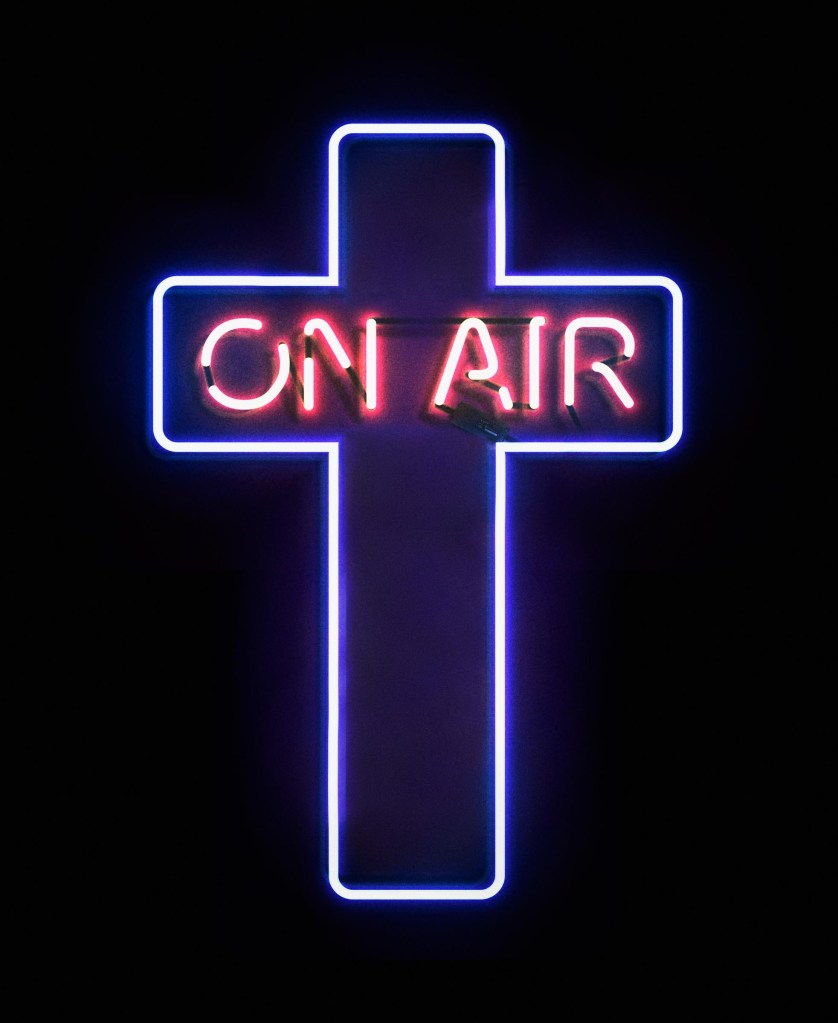
Illustration by Guillem Casasús
ON K-LOVE TODAY, you won’t hear any explicit politicking. You didn’t in the early days, either. For one thing, its nonprofit status means it can’t legally engage in any political campaign activity. (Perhaps it was merely a coincidence when, in the 1990s, EMF applied to build a new K-LOVE station on the same frequency as a Northern California community-radio station that had programming specifically for and by lesbians — prompting outcry from the existing station.) But conservatism is, in many ways, baked into the business. Fogal had the early support of Watergate “hatchet man” turned evangelical political commentator Chuck Colson. Over the years, EMF staff have donated primarily to conservative PACs. And though he was no longer involved with the company at the time, Fogal said in a 2022 interview that EMF was more necessary than ever, and that its enormity gave it “tremendous opportunities to impact our culture and even affect the direction of our country back towards God.” In the United States today, he asserted, “good is being called evil and vice versa. Evil is not just operating behind the scenes, it’s right there in our faces. Lawlessness. Post-term abortions. You name it.” (“Post-term abortions,” it should be noted, are not a thing.) Fogal went on to criticize his local Spokane City Council for allegedly underfunding the police while spending money on “Gay Pride-themed murals.”
Despite the apolitical front, the CCM industry has a major anti-LGBTQ problem. “I went to this meeting with a pretty big-time CCM music manager … and he was like, ‘You gotta stop baiting K-LOVE,’ ” Semler Baldridge tells me with a wry grin, her cropped bleach-blond hair falling comfortably across her forehead. Semler, who is queer, has tried repeatedly to get her music on K-LOVE, but it’s never happened — not even when her 2021 album, Preacher’s Kid, topped Apple’s Christian chart. While many of her songs deal with doubt and the realities of being a queer Christian — topics K-LOVE doesn’t touch — some of her songs are just plain worship music: poppy, repetitive, and perfect, she says, for K-LOVE. (Semler says she tried to capture the classic CCM sound on her song “Raise Up,” but “apparently it still sounded too gay.”) Last year, as her song “Faith” was on its way to Number One on the iTunes Christian chart, she took to X, formerly Twitter, to ask K-LOVE if it would play the explosive single. They never gave her the time of day. “It’s just so blatant, their exclusion of LGBTQ people,” she says. Though EMF hasn’t spoken ill of Christian artists who have come out, several queer artists have lost airtime on Christian radio after opening up about their sexuality.
Even so, Semler wishes she and other queer Christian artists could have the platform that K-LOVE would give her. “I’ve had some people on the inside [at EMF] that are like, ‘We’re affirming, we’re making progress, hang tight, hold tight.’ But I don’t know how much I’m willing to wait for that at this stage of my life.”
The more Semler dives into the mainstream world of Christian rock, the more she is turned off by it — and not just for its inability to support LGBTQ artists. She recently crashed a CCM award ceremony in Nashville called the Dove Awards. “The nicest cars I’ve seen in my life were at the Dove Awards,” she says. “We were talking about Jesus the whole time, and I was like, ‘He’d hate it here.’ ”
Though few and far between, other Christians have questioned the plush material conditions of industry leaders and EMF executives. In 2016, Warren Throckmorton, a retired psychology professor in Pennsylvania and evangelical blogger with a defiant streak, whose professional headshot looks straight out of The Blues Brothers, started blogging about red flags he heard on K-LOVE’s fundraising drives. He’d never had a bone to pick with K-LOVE before: He lived within earshot of three K-LOVE stations, his wife and kids listened; as a member of his church band, he’d learned to play many of the songs at the request of his younger congregants. But Throckmorton couldn’t defend the on-air hosts who praised a hard-up caller who donated to K-LOVE rather than paying an outstanding bill. And he found K-LOVE’s repeated asks for an “easy gift” of $40 a month disingenuous, especially when the nationwide, syndicated hosts would “say things like, ‘Help keep K-LOVE on the air in your area!’ ” Throckmorton recalls. “They weren’t using that money to keep local stations on the air. They were using that money to buy up new stations,” he says. “It seems like it is less ministry and more business.”
I prod Throckmorton a bit, mentioning the things that other Christians had told me they like about the stations: the positive messages and the inspirational stories in between songs. They have pastors on staff who field prayer requests, and who privately answer calls from distraught listeners (a service that EMF says has succeeded in everything from guiding people through crises of faith to averting suicide attempts). Throckmorton pauses, his tone somewhere between exasperation and bemusement. “If you can keep yourself unaware of some of the things that I pointed out, you can enjoy it.” He adds, “It spoiled it for me.”
Every weekday afternoon at three these days, DJ Mistress Carrie takes the mic at rock radio station the Pike in Worcester, a small city an hour west of Boston. It’s a good gig, but her old Boston listeners can’t hear it on their radios — the signal cuts out well beyond city limits on the Mass Turnpike. Sitting in her car outside her new workplace, though, she can easily pick up the massive K-LOVE signal that replaced WAAF. And just in case one station in the Boston area wasn’t enough, EMF bought a second signal there in 2022, giving K-LOVE extra reach into the North Shore and Gloucester. Like the stations that replaced WAAF, it’s just another unmanned transmitter, rebroadcasting the same bland Christian rock from California and spreading its conservative pop-culture alternative even farther.
Today, the Educational Media Foundation is everywhere. You can hear it on the air from New York to San Francisco, or tune in on the K-LOVE and Air1 apps. Starting at $1,148, you can join the K-LOVE Friends and Family Cruise. The company had a growth spurt during the pandemic, taking advantage of the advertising decline that hit commercial radio stations. Last year, EMF bought out stations in Memphis, Buffalo, Atlantic City, and dozens of other cities across the country. EMF gives even the biggest for-profit media conglomerates a run for their money: Just a handful of years ago, it bought six big city stations from Cumulus — the country’s third-largest station holder — for $103.5 million.
And true community broadcasters have even less of a chance in the face of EMF’s buying sprees — especially when the billion-dollar organization can offer iHeart-level prices for neighborhood stations.
Even as the media industry has grown increasingly consolidated, the FCC has held onto one major policy to give small broadcasters a ghost of a chance, and to keep any one company from having too much sway over the public: To this day, it is illegal for a single company to own more than five AM or five FM stations in any one city. But there’s a catch, says engineer and local-radio advocate Urick, a “loophole for noncommercial broadcasters”: The FCC never applied this ownership cap to nonprofits. It also doesn’t count translators, the meat of EMF’s explosive growth, toward those totals. “In the San Jose area,” Urick tells me, “they’re on eight (FM) frequencies.”
Today, a small number of community-media activists are still asking the FCC to limit the number of translators a single company could own, or to cap the number of frequencies a nonprofit can occupy in a single city, as it does with for-profits. But with the agency focused on things like internet access and digital privacy, radio — despite still being listened to by more than four of every five Americans every week — often gets overlooked. And EMF doesn’t appear to be raising eyebrows at the commission; it has no flashy violations, no big lawsuits. To Urick, it feels like a David-versus-Goliath fight, but Goliath keeps winning.
Those in the CCM industry know that the genre is a punchline for most Americans. And many people I spoke with told me that this may work to EMF’s advantage: That the organization evades scrutiny with the help of an intentionally prosaic facade, cloaking its money-stacking, culture-flattening project in banality. And this is nothing new for the group: When Fogal first incorporated the organization, it was called “Christian Media Ministries.” But before the first station launched, Fogal met with an attorney who helped churches to navigate the turbulent waters of the FCC. The attorney suggested that he change the organization’s name to the Educational Media Foundation. Fogal would say later that he felt the name was “bland and boring.” But the attorney, Fogal recalled, “said that was actually a good thing.” If the country’s second-largest radio-station owner was still named Christian Media Ministries, perhaps others would have taken notice.
Leah Payne warns critics against mistaking kitsch for a lack of importance and influence. The politicking and legislation of the religious right, she says, is the tip of the iceberg. Beneath it is a whole culture that includes not just politics, but entertainment, arts, and music. Those who hold the CCM cards are wielding conservatives’ soft power. “If we’re not attentive to them,” Payne says of those shaping the industry, “we’re going to miss out on a lot.”
But for now, EMF and the Christian-rock industry, it seems, are happy to be a joke if it keeps scrutinizing eyes off them. “The public just doesn’t really care what they’re doing,” says Urick.
Keep letting Christian rock be nothing more than a punchline. The Educational Media Foundation, it seems, thanks you.
